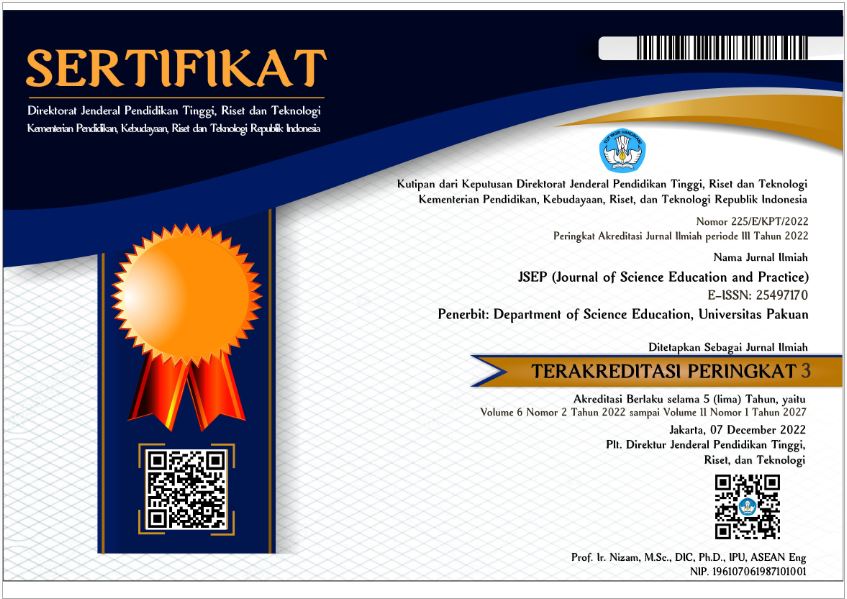ADDITIONAL MENU
Effectiveness of Deep Phet Interactive Simulation Improving Understanding of The Concept of Material Change
Abstract
Keywords
References
Ashraf Ali Bani Yassin. (2022). The Effect of Using Interactive Simulation (PhET) and Virtual Laboratories (Praxilabs) on Tenth-Grade Students’ Achievement in Physics. Britain International of Linguistics Arts and Education (BIoLAE) Journal, 4(2), 58–72. https://doi.org/10.33258/biolae.v4i2.693
Benninga, J. S., Berkowitz, M. W., & Kuehn, P. (2003). the Relationship of Character Education Implementation and Academic Achievement in Elementary Schools. Journal of Character Education, 1(1), 19–32.
Borg, W. R., & Gall, M. D. (2007). Educational Research An Introduction.
Brady, J. E., Jespersen, N. D., & Hyslop, A. (2014). Chemistry. John Wiley & Sons, Limited. https://books.google.co.id/books?id=KurHoQEACAAJ
Casa-Coila, M. D., Mamani-Vilca, P. S., Tisnado-Mamani, L. M., Pari-Achata, D., & Vilca-Apaza, H. M. (2023). Model Chemlab and Phet Simulator: A Didactic Resource for Chemistry Learning in Undergraduate Students. International Journal of Membrane Science and Technology, 10(5), 59–75. https://doi.org/10.15379/ijmst.v10i5.2420
Chang, R. (2005). Kimia Dasar: Konsep-Konsep Inti (Ketiga Jil). Penerbit Erlangga.
Chotimah, C., & Festiyed. (2021). Validity and practicality of worksheet assisted by PhET interactive simulations to improve students creative thinking skills in a research based learning model. Journal of Physics: Conference Series, 1876(1), 012060. https://doi.org/10.1088/1742-6596/1876/1/012060
Creswell, J. (2003). Research Design Qualitative, Quantitative and Mixed Methods Approaches. In Second Edition (p. 137).
Engelberger, F., Galaz-Davison, P., Bravo, G., Rivera, M., &
Ramírez-Sarmiento, C. A. (2021). Developing and Implementing Cloud-Based Tutorials That Combine Bioinformatics Software, Interactive Coding, and Visualization Exercises for Distance Learning on Structural Bioinformatics. Journal of Chemical Education, 98(5), 1801–1807. https://doi.org/10.1021/acs.jchemed.1c00022
Fraenkel, J. R. (2012). How to Design and Evaluate Research in Education. In The McGraw-Hill Companies.
Gall, M. D., Gall, J. P., & Borg, W. R. (2003). Education Research: An introduction, 7 th Eddition (pp. 1–656).
Gandhi, H. A., Jakymiw, S., Barrett, R., Mahaseth, H., & White, A. D. (2020). Real-time interactive simulation and visualization of organic molecules. Journal of Chemical Education, 97(11), 4189–4195. https://doi.org/10.1021/acs.jchemed.9b01161
Gilbert, B. C. T., Clapson, M. L., & Musgrove, A. (2020). ChemEscape, Polymer Chemistry: Solving Interactive Puzzles Featuring Scaffolded Learning to Promote Student Understanding of Polymers and Structure-Property Relationships. Journal of Chemical Education, 97(11), 4055–4062. https://doi.org/10.1021/acs.jchemed.0c00863
Gong, X., Wei, B., Bergey, B. W., & Shockley, E. T. (2023). Unpacking Chemistry Teachers’ Pedagogical Reasoning and Decisions for a PhET Simulation: A TPACK Perspective. Journal of Chemical Education, 100(1), 34–44. https://doi.org/10.1021/acs.jchemed.2c00397
Keenan, C. W. (1999). Kimia Untuk Universitas (Keenam Jil). Penerbit Erlangga.
Khoiri, A., Evalina, Komariah, N., Utami, R. T., Paramarta, V., Siswandi, Janudin, & Sunarsi, D. (2021). 4Cs Analysis of 21st Century Skills-Based School Areas. Journal of Physics: Conference Series, 1764(1), 0–10. https://doi.org/10.1088/1742-6596/1764/1/012142
Li, J., Yang, M. A., & Xue, Z. H. (2022). CHEMTrans: Playing an Interactive Board Game of Chemical Reaction Aeroplane Chess. Journal of Chemical Education, 99(2), 1060–1067. https://doi.org/10.1021/acs.jchemed.1c00333
Mahtari, S., Wati, M., Hartini, S., Misbah, M., & Dewantara, D. (2020). The effectiveness of the student worksheet with PhET simulation used scaffolding question prompt. Journal of Physics: Conference Series, 1422(1), 012010. https://doi.org/10.1088/1742-6596/1422/1/012010
Mallari, R. L. (2020). The Effectiveness of Integrating PhET Interactive Simulation-based Activities in Improving the Student’s Academic Performance in Science. International Journal for Research in Applied Science and Engineering Technology, 8(9), 1150–1153. https://doi.org/10.22214/ijraset.2020.31708
Mweene, P., & Muzaza, G. (2020). Implementation of Interactive Learning Media on Chemical Materials. In Journal Educational Verkenning. https://hdpublication.com/index.php/jev
Ndihokubwayo, K., Uwamahoro, J., & Ndayambaje, I. (2020). Effectiveness of PhET Simulations and YouTube Videos to Improve the Learning of Optics in Rwandan Secondary Schools. African Journal of Research in Mathematics, Science and Technology Education. https://doi.org/10.1080/18117295.2020.1818042
Ng, M. E., & Chua, K. H. (2023). The Effect of Using PhET in Changing Malaysian Students’ Attitude to Learning Physics in a Full Virtual Environment. Pertanika Journal of Social Sciences and Humanities, 31(2), 545–560.
https://doi.org/10.47836/pjssh.31.2.05
Ohn-Sabatello, T. (2020). Incorporating Technology Tools and the 5E Instructional Model to Teach High School Students Chemistry by Online Instruction. Journal of Chemical Education, 97(11), 4202–4208. https://doi.org/10.1021/acs.jchemed.0c00824
Petrucci, R. H. (2011). Kimia Dasar Prinsip-Prinsip dan Aplikasi Modern (Kesembilan). Penerbit Erlangga.
Qin, T., Cook, M., & Courtney, M. (2021). Exploring Chemistry with Wireless, PC-Less Portable Virtual Reality Laboratories. Journal of Chemical Education, 98(2), 521–529. https://doi.org/10.1021/acs.jchemed.0c00954
Rahmawati, Y., Zulhipri, Hartanto, O., Falani, I., & Iriyadi, D. (2022). Students’ Conceptual Understanding in Chemistry Learning Using PhET Interactive Simulations. Journal of Technology and Science Education, 12(2), 303–326. https://doi.org/10.3926/jotse.1597
Rodrigues, B. M., Santos, J. E. B. dos, & Vasconcelos, C. A. (2020). Conceptions of undergraduate students in Chemistry on the use of interactive interfaces in and for the activities developed in the distance course. JOURNAL OF RESEARCH AND KNOWLEDGE SPREADING, 1(1), e11649. https://doi.org/10.20952/jrks1111649
Salame, I. I., & Makki, J. (2021). Examining the Use of PhET Simulations on Students’ Attitudes and Learning in General Chemistry II. Interdisciplinary Journal of Environmental and Science Education, 17(4), e2247. https://doi.org/10.21601/ijese/10966
Saudelli, M. G., Kleiv, R., Davies, J., Jungmark, M., & Mueller, R. (2021). PhET Simulations in Undergraduate Physics: Constructivist Learning Theory in Practice. In 52 Brock Education Journal (Vol. 31, Issue 1). https://journals.library.brocku.ca/brocked
Sugiyono. (2011). Metode Penelitian Kuantitatif, Kualitatif dan R&D.
Thabiea, ; M M, Mahinay, C. J. D., Tutor, K. J. B., & Malayao, S. O. (2022). Development of Vodcast on Thermodynamics embedded with PhET Simulation for Enhanced Learning. Thabiea : Journal of Natural Science Teaching, 5(2), 98–117. http://journal.iainkudus.ac.id/index.php/Thabiea
Yunzal, A. N., & Casinillo, L. F. (2020). Effect of Physics Education Technology (PhET) Simulations: Evidence from STEM Students’ Performance. Journal of Educational Research and Evaluation, 4(3), 221–226. https://ejournal.undiksha.ac.id/index.php/JERE
DOI: 10.33751/jsep.v7i2.9213
 Abstract views : 624
Abstract views : 624
Refbacks
- There are currently no refbacks.
Copyright (c) 2024 JSEP (Journal of Science Education and Practice)

This work is licensed under a Creative Commons Attribution 4.0 International License.













